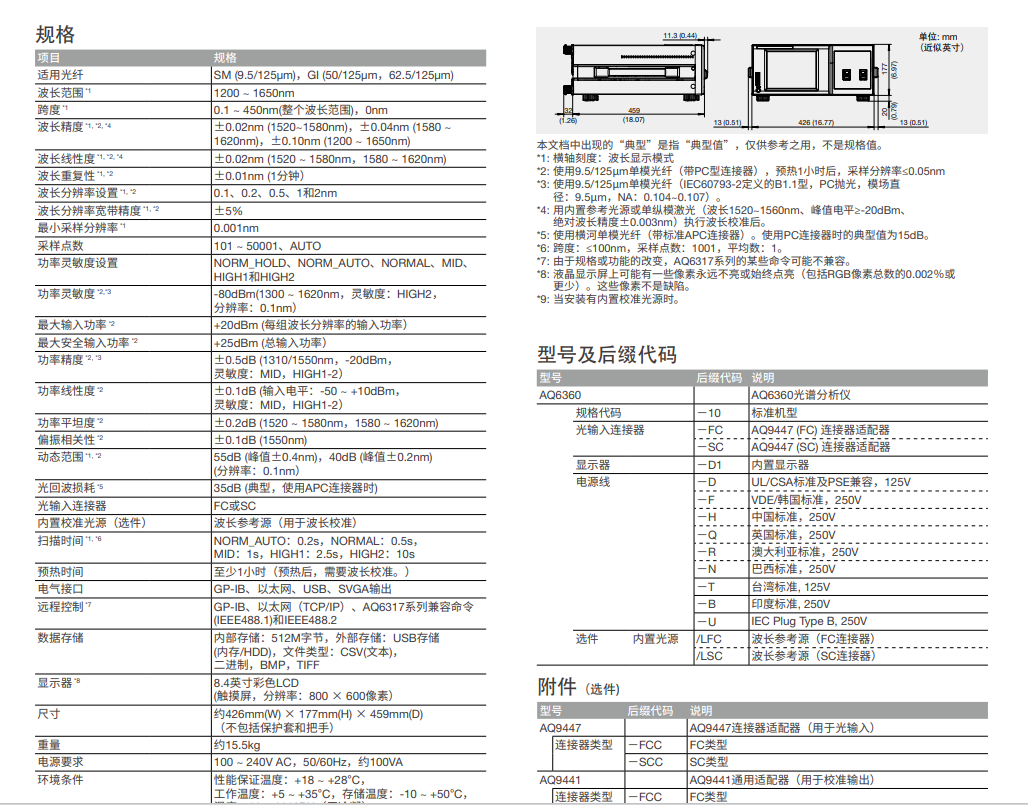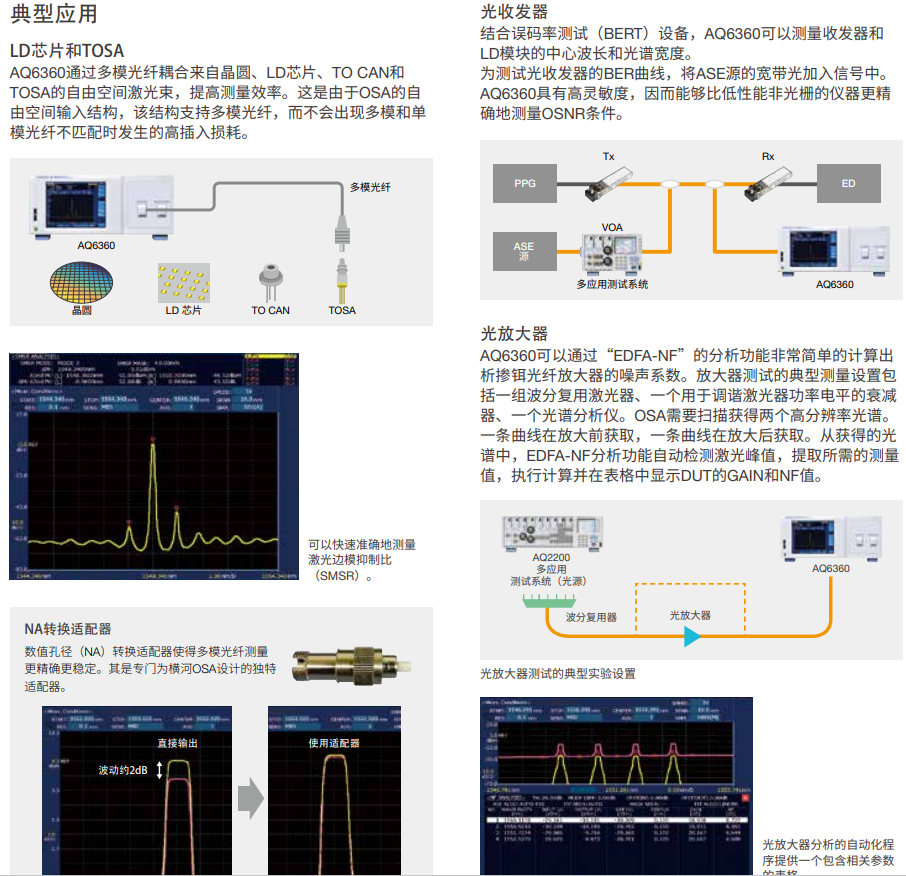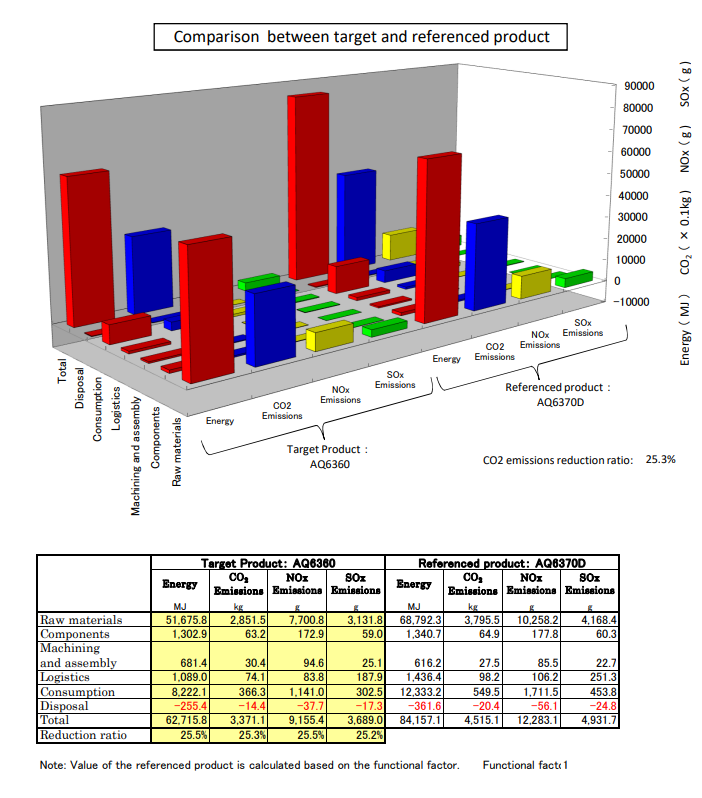AQ6360 Yokogawa Spectrum Analyser Essentials, Bookmark and save!
AQ6360 is a spectrum analyser produced by Yokogawa, Japan, and its main technical parameters include wavelength range, wavelength accuracy and wavelength linearity, etc. The wavelength range of the AQ6360 is 1200~1650nm, with high wavelength accuracy of ±0.02nm in the range of 1520~1580nm, ±0.04nm in the range of 1580~1620nm, and ±0.10nm in the range of 1200~1650nm. In addition, the AQ6360 has a high dynamic range of 55dB.
Designed with ideal performance for manufacturing testing in mind, the AQ6360's free-space optical input structure design ensures high coupling efficiency and measurement repeatability. The instrument supports built-in analysis functions and is equipped with Ethernet and GPIB remote interfaces for easy construction of automated test systems.
The AQ6360 is a cost-effective spectrum analyser based on diffraction grating technology, which provides users with a high-performance and high-precision spectrum analysis solution through its advanced technology and design.

What are the key performance differences between the AQ6360 and other comparable spectrum analysers such as the AQ6350?
Wavelength range: The AQ6360 has a wavelength range of 1200 to 1650 nm, which indicates that it is able to cover the testing needs of components such as lasers, optical transceivers and optical amplifiers that are commonly used in the manufacture of telecoms equipment.
Measurement range: The AQ6360 has a wide measurement range from 20 to -80 dB, which means that it is able to provide a wide range of signal strength measurements for different test environments.
Technical basis: The AQ6360 is based on diffraction grating technology, a highly efficient spectral analysis technique that provides accurate measurements. The application of this technology gives the AQ6360 an advantage in terms of economy and efficiency.
Applicable scenarios: The AQ6360 is primarily aimed at production testing of datacom and telecom equipment such as laser diodes, optical transceivers and optical amplifiers. This may differ from the original design intent of some other models, which may be more orientated towards R&D purposes.
Scanning Speed: The AQ6360 scans twice as fast as other models designed for R&D purposes, a feature that significantly improves production throughput and is especially important for application scenarios that require a large number of fast tests.
User Interface: The AQ6360 follows the screen and menu layout of the OSA series, which is recognised by thousands of users worldwide as one of the most intuitive and easy to use layouts. This means that the AQ6360 has a clear advantage in terms of user experience, especially for those already familiar with the operation of Yokogawa spectrum analysers.
The AQ6360 differs significantly from other comparable spectrum analysers in terms of wavelength range, measurement range, technology base, applicability scenarios, scanning speed, and user interface, all of which are features that make it an excellent performer in the industrial manufacturing of telecommunications equipment.

What are the latest technology updates or improvement points of the AQ6360 Spectrum Analyser?
There are three main areas: narrower scanning range, reduced resolution, and significantly faster scanning speed. In addition, it features a high-resolution and responsive 8.4-inch multi-touch capacitive touchscreen, making the instrument easy and intuitive to operate, and a wide range of built-in data analysis functions to increase productivity. Together, these improvements enhance the efficiency and user experience of the AQ6360 Spectrum Analyser in chip manufacturing.
What are some case studies or success stories of the AQ6360 Spectrum Analyser in action?
The case studies or success stories of the AQ6360 spectral analyser in real-world applications are mainly based on its wide range of application areas and the fulfilment of specific technological needs.The AQ6360 is a cost-effective spectral analyser based on diffraction grating technology in the wavelength range of 1,200 to 1,650 nm designed to meet the typical measurement needs of the telecom equipment industry (e.g. lasers, optical transceivers, and optical amplifiers). manufacturing typical measurement needs. This demonstrates the important role the AQ6360 plays in the development and production of telecoms equipment.
In addition, the AQ6360 is used in a wide range of applications such as fibre-optic communications, fibre-optic sensors and optical device research. The diversity of these applications further demonstrates the versatility and high efficiency of the AQ6360 to meet the needs of different industries for spectral analysis. Especially in the field of fibre optic communications, the AQ6360 provides strong support for the development of fibre optic communications technology by measuring and analysing the performance of optical components and optical systems.
The success story of the AQ6360 spectral analyser in practical applications is mainly reflected in its contribution to the fields of telecommunication equipment manufacturing, fibre-optic communications, fibre-optic sensors and optical device research. By providing accurate spectral analysis, the AQ6360 has helped the relevant industries to improve product quality and R&D efficiency, and is one of the indispensable tools in these fields.

What key information does the Maintenance and Operation Guide for the AQ6360 Spectrum Analyser include?
Basic information about the user manual: This includes the brand (YOKOGAWA) and model number (AQ6360, AQ6360-01) of the device, as well as the basic attributes of the document, such as the type of material being a user's guide, the language being English, the date of generation, etc.45 This basic information helps the user to understand the background of the document and its scope of application.
Technical parameters of the device: although specific technical parameters were not detailed in the materials I searched for, it can be surmised from the description of the Yokogawa AQ6360 spectral analyser that the device supports the completion of wavelength calibration (Wl Cal) after automated optical axis positioning, and that it performs measurements at a constant temperature. In addition, the requirement to use a specific type of optical fibre (e.g. single-mode fibre ITU-T G.652 with return loss greater than 40 dB or multimode fibre 50 μm/125 μm) for the measurements is mentioned. This information is critical to understanding the operating conditions and performance requirements of the equipment.
The AQ6360 Spectrum Analyser Maintenance and Operation Guide may contain key information on the basic information, technical parameters, operating conditions, maintenance requirements, etc. of the equipment.

AQ6360 is a spectrum analyser produced by Yokogawa, Japan, and its main technical parameters include wavelength range, wavelength accuracy and wavelength linearity, etc. The wavelength range of the AQ6360 is 1200~1650nm, with high wavelength accuracy of ±0.02nm in the range of 1520~1580nm, ±0.04nm in the range of 1580~1620nm, and ±0.10nm in the range of 1200~1650nm. In addition, the AQ6360 has a high dynamic range of 55dB.
Designed with ideal performance for manufacturing testing in mind, the AQ6360's free-space optical input structure design ensures high coupling efficiency and measurement repeatability. The instrument supports built-in analysis functions and is equipped with Ethernet and GPIB remote interfaces for easy construction of automated test systems.
The AQ6360 is a cost-effective spectrum analyser based on diffraction grating technology, which provides users with a high-performance and high-precision spectrum analysis solution through its advanced technology and design.

What are the key performance differences between the AQ6360 and other comparable spectrum analysers such as the AQ6350?
Wavelength range: The AQ6360 has a wavelength range of 1200 to 1650 nm, which indicates that it is able to cover the testing needs of components such as lasers, optical transceivers and optical amplifiers that are commonly used in the manufacture of telecoms equipment.
Measurement range: The AQ6360 has a wide measurement range from 20 to -80 dB, which means that it is able to provide a wide range of signal strength measurements for different test environments.
Technical basis: The AQ6360 is based on diffraction grating technology, a highly efficient spectral analysis technique that provides accurate measurements. The application of this technology gives the AQ6360 an advantage in terms of economy and efficiency.
Applicable scenarios: The AQ6360 is primarily aimed at production testing of datacom and telecom equipment such as laser diodes, optical transceivers and optical amplifiers. This may differ from the original design intent of some other models, which may be more orientated towards R&D purposes.
Scanning Speed: The AQ6360 scans twice as fast as other models designed for R&D purposes, a feature that significantly improves production throughput and is especially important for application scenarios that require a large number of fast tests.
User Interface: The AQ6360 follows the screen and menu layout of the OSA series, which is recognised by thousands of users worldwide as one of the most intuitive and easy to use layouts. This means that the AQ6360 has a clear advantage in terms of user experience, especially for those already familiar with the operation of Yokogawa spectrum analysers.
The AQ6360 differs significantly from other comparable spectrum analysers in terms of wavelength range, measurement range, technology base, applicability scenarios, scanning speed, and user interface, all of which are features that make it an excellent performer in the industrial manufacturing of telecommunications equipment.

What are the latest technology updates or improvement points of the AQ6360 Spectrum Analyser?
There are three main areas: narrower scanning range, reduced resolution, and significantly faster scanning speed. In addition, it features a high-resolution and responsive 8.4-inch multi-touch capacitive touchscreen, making the instrument easy and intuitive to operate, and a wide range of built-in data analysis functions to increase productivity. Together, these improvements enhance the efficiency and user experience of the AQ6360 Spectrum Analyser in chip manufacturing.
What are some case studies or success stories of the AQ6360 Spectrum Analyser in action?
The case studies or success stories of the AQ6360 spectral analyser in real-world applications are mainly based on its wide range of application areas and the fulfilment of specific technological needs.The AQ6360 is a cost-effective spectral analyser based on diffraction grating technology in the wavelength range of 1,200 to 1,650 nm designed to meet the typical measurement needs of the telecom equipment industry (e.g. lasers, optical transceivers, and optical amplifiers). manufacturing typical measurement needs. This demonstrates the important role the AQ6360 plays in the development and production of telecoms equipment.
In addition, the AQ6360 is used in a wide range of applications such as fibre-optic communications, fibre-optic sensors and optical device research. The diversity of these applications further demonstrates the versatility and high efficiency of the AQ6360 to meet the needs of different industries for spectral analysis. Especially in the field of fibre optic communications, the AQ6360 provides strong support for the development of fibre optic communications technology by measuring and analysing the performance of optical components and optical systems.
The success story of the AQ6360 spectral analyser in practical applications is mainly reflected in its contribution to the fields of telecommunication equipment manufacturing, fibre-optic communications, fibre-optic sensors and optical device research. By providing accurate spectral analysis, the AQ6360 has helped the relevant industries to improve product quality and R&D efficiency, and is one of the indispensable tools in these fields.

What key information does the Maintenance and Operation Guide for the AQ6360 Spectrum Analyser include?
Basic information about the user manual: This includes the brand (YOKOGAWA) and model number (AQ6360, AQ6360-01) of the device, as well as the basic attributes of the document, such as the type of material being a user's guide, the language being English, the date of generation, etc.45 This basic information helps the user to understand the background of the document and its scope of application.
Technical parameters of the device: although specific technical parameters were not detailed in the materials I searched for, it can be surmised from the description of the Yokogawa AQ6360 spectral analyser that the device supports the completion of wavelength calibration (Wl Cal) after automated optical axis positioning, and that it performs measurements at a constant temperature. In addition, the requirement to use a specific type of optical fibre (e.g. single-mode fibre ITU-T G.652 with return loss greater than 40 dB or multimode fibre 50 μm/125 μm) for the measurements is mentioned. This information is critical to understanding the operating conditions and performance requirements of the equipment.
The AQ6360 Spectrum Analyser Maintenance and Operation Guide may contain key information on the basic information, technical parameters, operating conditions, maintenance requirements, etc. of the equipment.








